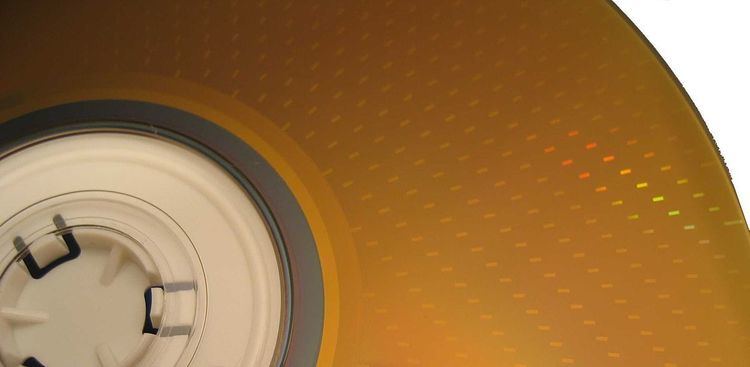 | ||
DVD-RAM (DVD–Random Access Memory) is a disc specification presented in 1996 by the DVD Forum, which specifies rewritable DVD-RAM media and the appropriate DVD writers. DVD-RAM media have been used in computers as well as camcorders and personal video recorders since 1998.
Contents
Design
DVD-RAM was one of three competing technologies for rewritable DVDs. Its competitors are DVD-RW and DVD+RW. DVD-RAM technology provides good data integrity, data retention and damage protection through a number of mechanisms and properties. Therefore, DVD-RAM is perceived by people (who need to store their data on DVDs for long periods of time) to be better than the other DVD technologies for traditional computer usage tasks such as general data storage, and especially data backup and archival. The Mount Rainier Format standard and SecurDisc for DVD±RW (which also works on DVD-RAM, CD-R, and CD-RW) somewhat lessens the DVD-RAM format's perceived advantage in the data integrity category, but not in the data retention or damage protection categories.
DVD-RAM has a larger presence in camcorders and set-top boxes than in computers, although the popularity of DVD-RAM in these devices can be explained by its being very easily written to and erased, which for example allows extensive in-camera editing.
The on-disc structure of DVD-RAM is closely related to hard disk and floppy disk technology, as it stores data in concentric tracks. DVD-RAMs can be accessed just like a hard or floppy disk and usually without any special software. DVD-RWs and DVD+RWs, on the other hand, store data in one long spiral track and require special packet reading/writing software to read and write data discs. Like magneto-optical (MO) technologies, DVD-RAM has numerous rectangles on the disc surface that define the boundaries of data sectors. However, DVD-RAM is not MO but a phase transition medium, similar to CD-RW, DVD-RW, or DVD+RW.
Specification
Since the Internationale Funkausstellung Berlin 2003 the specification is being marketed by the RAM Promotion Group (RAMPRG), built by Hitachi, Toshiba, Maxell, LG Electronics, Matsushita/Panasonic, Samsung, Lite-On and Teac. The specification distinguishes between:
Physically smaller, 80 mm in diameter, DVD-RAM discs also exist with a capacity of 1.46 GB for a single-sided disc and 2.8 GB for a double-sided disk, but they are uncommon. DVD-RAMs were originally solely sold in cartridges; recent DVD recorders can work with discs either with or without a cartridge, and many devices do not work with cartridges. Discs can be removed from cartridges for use with these drives (except with type 1 media, see table above).
Compatibility
Many operating systems like the classic Mac OS (from Mac OS 8.6 up), macOS, Linux, and Microsoft Windows XP can use DVD-RAM directly, while earlier versions of Windows require separate device drivers or the program InCD.
Windows XP Home and Professional can only write directly to FAT32 formatted DVD-RAM discs. For UDF formatted discs, which are considered faster, a third-party UDF file system driver capable of writing or software such as InCD or DLA are required. Windows Vista and later can natively access and write to both FAT32 and UDF formatted DVD-RAM discs using mastered burning method or packet writing. Even though it is possible to use any file system one likes, very few perform well on DVD-RAM. This is because some file systems frequently overwrite data on the disc and the table of contents is contained at the start of the disc. It should also be noted that Windows Vista (and later) implement the CPRM data protection and thus discs formatted under Windows XP (or earlier) have compatibility issues with Vista onwards (and vice versa).
The classic Mac OS up to 9.2 can read and write HFS, HFS+, FAT, and UDF formatted DVD-RAM discs directly. In Mac OS X (versions 10.0.x through 10.4.x) UDF-formatting of DVD-RAM is no longer supported, instead formatting and writing DVD-RAM is done in HFS+ format. (UDF support was re-implemented in 10.5 Leopard) (HFS and UFS should also be supported on older versions of Mac OS X that retain support for these file systems.)
Many DVD standalone players and recorders do not work with DVD-RAM. However, within "RAMPRG" (the DVD-RAM Promotion Group consisting of Hitachi, Toshiba, Maxell, LG Electronics, Matsushita/Panasonic, Samsung, Lite-On, Teac) there are a number of well-known manufacturers of standalone players, recorders, and camcorders that can use DVD-RAM. Panasonic, for instance, has a range of players and recorders which make full use of the advantages of DVD-RAM.
The newest DVD-RAM Specification, DVD-RAM2 (also called RAM2), is not compatible with DVD drives that do not specifically allow reading DVD-RAM2 discs.
Some high end products such as IBM System p frames require DVD-RAM instead of DVD-RW.
